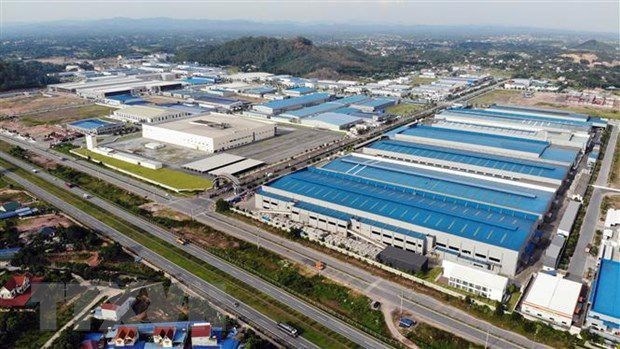MPI pondering overhaul of vital economic zones to drive growth
 |
| An IP in Ba Ria - Vung Tau (Photo: VNA) |
The Ministry of Planning and Investment (MPI) has been assigned to draft the national master plan for this decade, with a vision to 2050. MPI Minister Nguyen Chi Dung said, “When resources are going to be limited, in some periods it is necessary to prioritise investment in a number of areas with the most favourable conditions so that those regions can lead the evolution of the others.”
According to Tran Hong Quang, director general of the MPI’s Development Strategy Institute, the areas with the most favourable position currently include those that boast international airports and seaports, but those strong in sci-tech, innovation, and high-quality human resources would also be considered to become key driving regions.
The MPI has thus far highlighted two notable areas to become vital driving economic regions for the nation as a whole, which could effectively replace the notion of key economic zones. The Northern region covers Hanoi and the provinces of Bac Ninh, Hai Duong, Haiphong, and Quang Ninh, contributing around 23 per cent of the country’s GDP and 30 per cent of the state budget revenue.
Meanwhile, the southern region covers Ho Chi Minh City and the provinces of Binh Duong, Dong Nai, and Ba Ria-Vung Tau, contributing up to 35 per cent of the country’s GDP and up to 39 per cent of state budget revenue.
“These two areas are developing well, and are the most important areas for the country’s development. The infrastructure system of these areas is quite good, including expressways, seaports, international airports, along with high-quality human resources, and a high capacity for science, technology, and innovation,” said Quang.
The MPI also plans to enable two areas to become secondary economic regions. Of these, Danang-Quang Ngai has the most advantageous conditions and developed infrastructure of the central region, including room for tourism and service development. It contributes close to 3.5 per cent to the country’s GDP and around 4 per cent to the state.
Elsewhere, the southern triangle of Can Tho, An Giang, and Kien Giang contributes up to 3.7 per cent to the country’s GDP and around 2 per cent of state revenues. “It is necessary to establish and develop some driving economic regions in Vietnam in the next 10-20 years. We will consider allocating resources massively to all areas of the country in the vision to 2050 and we should agree with the gaps in development among various areas,” said economist Duong Dinh Giam.
Pham Trung Luong, former deputy director of the Institute for Tourism Development Research, said that it will be quite difficult to strengthen the links among some regions.
“At present, despite being the centre of the north-central region, Hue city does not play a leading role, while Thanh Hoa province is being affected by Hanoi but not impacted by Hue or any localities in the region. The central role of the locality in this region is not as strong as expected, so we should determine the region more precisely in this master plan to promote the advantages and development of all localities there,” said Luong.
At present, there are four key economic regions in the country, covering 24 cities and provinces, and seven key economic zones. Over past years, key economic regions have made important contributions to the overall growth rate of the economy. On average, all four key economic regions contributed 73 per cent to the average GDP growth rate of the entire economy in the period between 2011 and 2019.
However, key economic regions have not brought into full play their available potential and advantages to seize opportunities and development, according to some experts. They are facing many challenges such as slowing economic growth; a slowly-increasing proportion of industry-construction and service sectors contributing to a less-sustainable state budget; and some localities’ revenue sources still depend on certain industries, with regional coordination mechanisms not effective enough and loose links between sectors and fields.
“The national planning of driving economic regions replacing key economic regions is expected to remove challenges of regional development, improve competitiveness, strengthen links among regions and between regions and overseas, and boost economic development,” said Quang from the Development Strategy Institute.
What the stars mean:
★ Poor ★ ★ Promising ★★★ Good ★★★★ Very good ★★★★★ Exceptional
Related Contents
Latest News
More News
- Global partnerships key to Vietnam’s IFC development (December 26, 2025 | 16:18)
- Vingroup pulls out of bid to invest in North-South high-speed railway (December 26, 2025 | 11:42)
- Strengthening supply chains through trade promotions and customs reform (December 24, 2025 | 14:00)
- PM orders investment model for North–South high-speed rail (December 22, 2025 | 17:43)
- LS Eco Energy to invest in Vietnam rare earth sector (December 22, 2025 | 17:31)
- Government moves to establish International Financial Centre (December 21, 2025 | 21:00)
- Vietnam's IFC to target global investment flows (December 21, 2025 | 18:00)
- Two national hospitals expand capacity with new facilities (December 20, 2025 | 09:00)
- Ha Tinh breaks ground on major Vingroup industrial and energy projects (December 19, 2025 | 18:24)
- EVN launches major power infrastructure projects nationwide (December 19, 2025 | 18:17)

 Tag:
Tag:





















 Mobile Version
Mobile Version